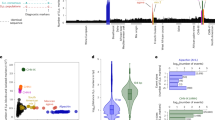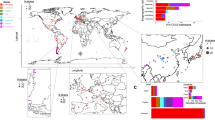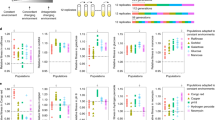Abstract
Local adaptations within species are often governed by several interacting genes scattered throughout the genome. Single-locus models of selection cannot explain the maintenance of such complex variation because recombination separates co-adapted alleles. Here we report a previously unrecognized type of intraspecific multi-locus genetic variation that has been maintained over a vast period. The galactose (GAL) utilization gene network of Saccharomyces kudriavzevii, a relative of brewer’s yeast, exists in two distinct states: a functional gene network in Portuguese strains and, in Japanese strains, a non-functional gene network of allelic pseudogenes. Genome sequencing of all available S. kudriavzevii strains revealed that none of the functional GAL genes were acquired from other species. Rather, these polymorphisms have been maintained for nearly the entire history of the species, despite more recent gene flow genome-wide. Experimental evidence suggests that inactivation of the GAL3 and GAL80 regulatory genes facilitated the origin and long-term maintenance of the two gene network states. This striking example of a balanced unlinked gene network polymorphism introduces a remarkable type of intraspecific variation that may be widespread.
This is a preview of subscription content, access via your institution
Access options
Subscribe to this journal
Receive 51 print issues and online access
$199.00 per year
only $3.90 per issue
Buy this article
- Purchase on Springer Link
- Instant access to full article PDF
Prices may be subject to local taxes which are calculated during checkout




Similar content being viewed by others
Accession codes
Data deposits
All short sequencing reads are deposited with Sequence Read Archive at the National Center for Biotechnology Information under accession number SRP001457 of SRA010159; the IFO1803 and ZP591 GAL sequences are deposited in GenBank under accession numbers GU299171–GU299178.
References
Levene, H. Genetic equilibrium when more than one ecological niche is available. Am. Nat. 87, 331–333 (1953)
Hughes, A. L. & Nei, M. Pattern of nucleotide substitution at major histocompatibility complex class I loci reveals overdominant selection. Nature 335, 167–170 (1988)
Klein, J., Sato, A., Nagl, S. & O’hUigín, C. Molecular trans-species polymorphism. Annu. Rev. Ecol. Syst. 29, 1–21 (1998)
Stahl, E. A., Dwyer, G., Mauricio, R., Kreitman, M. & Bergelson, J. Dynamics of disease resistance polymorphism at the Rpm1 locus of Arabidopsis . Nature 400, 667–671 (1999)
Colosimo, P. F. et al. Widespread parallel evolution in sticklebacks by repeated fixation of Ectodysplasin alleles. Science 307, 1928–1933 (2005)
Kroymann, J. & Mitchell-Olds, T. Epistasis and balanced polymorphism influencing complex trait variation. Nature 435, 95–98 (2005)
Charlesworth, D. Balancing selection and its effects on sequences in nearby genome regions. PLoS Genet. 2, e64 (2006)
Mitchell-Olds, T., Willis, J. H. & Goldstein, D. B. Which evolutionary processes influence natural genetic variation for phenotypic traits? Nature Rev. Genet. 8, 845–856 (2007)
Storz, J. F. et al. The molecular basis of high-altitude adaptation in deer mice. PLoS Genet. 3, e45 (2007)
Hawthorne, D. J. & Via, S. Genetic linkage of ecological specialization and reproductive isolation in pea aphids. Nature 412, 904–907 (2001)
Brem, R. B., Storey, J. D., Whittle, J. & Kruglyak, L. Genetic interactions between polymorphisms that affect gene expression in yeast. Nature 436, 701–703 (2005)
Steiner, C. C., Weber, J. N. & Hoekstra, H. E. Adaptive variation in beach mice produced by two interacting pigmentation genes. PLoS Biol. 5, e219 (2007)
Gerke, J., Lorenz, K. & Cohen, B. Genetic interactions between transcription factors cause natural variation in yeast. Science 323, 498–501 (2009)
Navarro, A. & Barton, N. H. The effects of multilocus balancing selection on neutral variability. Genetics 161, 849–863 (2002)
Dobzhansky, T. & Pavlovsky, O. Interracial hybridization and breakdown of coadapted gene complexes in Drosophila paulistorum and Drosophila willistoni . Proc. Natl Acad. Sci. USA 44, 622–629 (1958)
Wu, C. I. & Ting, C. T. Genes and speciation. Nature Rev. Genet. 5, 114–122 (2004)
Turner, T. L., Hahn, M. W. & Nuzhdin, S. V. Genomic islands of speciation in Anopheles gambiae . PLoS Biol. 3, e285 (2005)
Wright, S. Genic and organismic selection. Evolution 34, 825–843 (1980)
Neher, R. A. & Shraiman, B. I. Competition between recombination and epistasis can cause a transition from allele to genotype selection. Proc. Natl Acad. Sci. USA 106, 6866–6871 (2009)
Clark, R. M. et al. Common sequence polymorphisms shaping genetic diversity in Arabidopsis thaliana . Science 317, 338–342 (2007)
Coyne, J. A. & Orr, H. A. Speciation (Sinauer Associates, 2004)
Johnston, M. A model fungal gene regulatory mechanism: the GAL genes of Saccharomyces cerevisiae . Microbiol. Rev. 51, 458–476 (1987)
Bhat, P. J. & Murthy, T. V. Transcriptional control of the GAL/MEL regulon of yeast Saccharomyces cerevisiae: mechanism of galactose-mediated signal transduction. Mol. Microbiol. 40, 1059–1066 (2001)
Ptashne, M. & Gann, A. Genes and Signals (Cold Spring Harbor Laboratory Press, 2001)
Hittinger, C. T., Rokas, A. & Carroll, S. B. Parallel inactivation of multiple GAL pathway genes and ecological diversification in yeasts. Proc. Natl Acad. Sci. USA 101, 14144–14149 (2004)
Martchenko, M., Levitin, A., Hogues, H., Nantel, A. & Whiteway, M. Transcriptional rewiring of fungal galactose-metabolism circuitry. Curr. Biol. 17, 1007–1013 (2007)
MacLean, R. C. Pleiotropy and GAL pathway degeneration in yeast. J. Evol. Biol. 20, 1333–1338 (2007)
Hittinger, C. T. & Carroll, S. B. Gene duplication and the adaptive evolution of a classic genetic switch. Nature 449, 677–681 (2007)
Raj, A. & van Oudenaarden, A. Nature, nurture, or chance: stochastic gene expression and its consequences. Cell 135, 216–226 (2008)
Sampaio, J. P. & Goncalves, P. Natural populations of Saccharomyces kudriavzevii in Portugal are associated with oak bark and are sympatric with S. cerevisiae and S. paradoxus . Appl. Environ. Microbiol. 74, 2144–2152 (2008)
Doniger, S. W. et al. A catalog of neutral and deleterious polymorphism in yeast. PLoS Genet. 4, e1000183 (2008)
Liti, G. et al. Population genomics of domestic and wild yeasts. Nature 458, 337–341 (2009)
Gonzalez, S. S., Barrio, E., Gafner, J. & Querol, A. Natural hybrids from Saccharomyces cerevisiae, Saccharomyces bayanus and Saccharomyces kudriavzevii in wine fermentations. FEMS Yeast Res. 6, 1221–1234 (2006)
Cliften, P. et al. Finding functional features in Saccharomyces genomes by phylogenetic footprinting. Science 301, 71–76 (2003)
Bensasson, D., Zarowiecki, M., Burt, A. & Koufopanou, V. Rapid evolution of yeast centromeres in the absence of drive. Genetics 178, 2161–2167 (2008)
Schacherer, J., Shapiro, J. A., Ruderfer, D. M. & Kruglyak, L. Comprehensive polymorphism survey elucidates population structure of Saccharomyces cerevisiae . Nature 458, 342–345 (2009)
Tsai, I. J., Bensasson, D., Burt, A. & Koufopanou, V. Population genomics of the wild yeast Saccharomyces paradoxus: quantifying the life cycle. Proc. Natl Acad. Sci. USA 105, 4957–4962 (2008)
Bubb, K. L. et al. Scan of human genome reveals no new loci under ancient balancing selection. Genetics 173, 2165–2177 (2006)
Ossowski, S. et al. Sequencing of natural strains of Arabidopsis thaliana with short reads. Genome Res. 18, 2024–2033 (2008)
Bentley, D. R. et al. Accurate whole human genome sequencing using reversible terminator chemistry. Nature 456, 53–59 (2008)
Gibbons, J. G. et al. Benchmarking next-generation transcriptome sequencing for functional and evolutionary genomics. Mol. Biol. Evol. 26, 2731–2744 (2009)
Smith, A. D., Xuan, Z. & Zhang, M. Q. Using quality scores and longer reads improves accuracy of Solexa read mapping. BMC Bioinformatics 9, 128 (2008)
Zerbino, D. R. & Birney, E. Velvet: algorithms for de novo short read assembly using de Bruijn graphs. Genome Res. 18, 821–829 (2008)
Shimodaira, H. & Hasegawa, M. Multiple comparisons of log-likelihoods with applications to phylogenetic inference. Mol. Biol. Evol. 16, 1114–1116 (1999)
Goffeau, A. et al. Life with 6000 genes. Science 274, 546 563–567 (1996)
Kellis, M., Patterson, N., Endrizzi, M., Birren, B. & Lander, E. S. Sequencing and comparison of yeast species to identify genes and regulatory elements. Nature 423, 241–254 (2003)
Morgenstern, B. DIALIGN 2: improvement of the segment-to-segment approach to multiple sequence alignment. Bioinformatics 15, 211–218 (1999)
Huelsenbeck, J. P. & Ronquist, F. MRBAYES: Bayesian inference of phylogenetic trees. Bioinformatics 17, 754–755 (2001)
Ronquist, F. & Huelsenbeck, J. P. MrBayes 3: Bayesian phylogenetic inference under mixed models. Bioinformatics 19, 1572–1574 (2003)
Altekar, G., Dwarkadas, S., Huelsenbeck, J. P. & Ronquist, F. Parallel Metropolis coupled Markov chain Monte Carlo for Bayesian phylogenetic inference. Bioinformatics 20, 407–415 (2004)
Lanave, C., Preparata, G., Saccone, C. & Serio, G. A new method for calculating evolutionary substitution rates. J. Mol. Evol. 20, 86–93 (1984)
Swofford, D. L. PAUP*: Phylogenetic Analysis Using Parsimony (*and Other Methods). Version 4.0b10 edn (Sinauer, 2002)
Posada, D. & Crandall, K. A. MODELTEST: testing the model of DNA substitution. Bioinformatics 14, 817–818 (1998)
Drummond, A. J. & Rambaut, A. BEAST: Bayesian evolutionary analysis by sampling trees. BMC Evol. Biol. 7, 214 (2007)
Nei, M. & Gojobori, T. Simple methods for estimating the numbers of synonymous and nonsynonymous nucleotide substitutions. Mol. Biol. Evol. 3, 418–426 (1986)
Yang, Z. PAML 4: phylogenetic analysis by maximum likelihood. Mol. Biol. Evol. 24, 1586–1591 (2007)
Rozas, J., Sanchez-DelBarrio, J. C., Messeguer, X. & Rozas, R. DnaSP, DNA polymorphism analyses by the coalescent and other methods. Bioinformatics 19, 2496–2497 (2003)
Ashburner, M. et al. Gene ontology: tool for the unification of biology. The Gene Ontology Consortium. Nature Genet. 25, 25–29 (2000)
Goldstein, A. L. & McCusker, J. H. Three new dominant drug resistance cassettes for gene disruption in Saccharomyces cerevisiae . Yeast 15, 1541–1553 (1999)
Guldener, U., Heck, S., Fielder, T., Beinhauer, J. & Hegemann, J. H. A new efficient gene disruption cassette for repeated use in budding yeast. Nucleic Acids Res. 24, 2519–2524 (1996)
Gietz, R. D. & Schiestl, R. H. Transforming yeast with DNA. Methods Mol. Cell. Biol. 5, 255–269 (1995)
Acknowledgements
We thank E. Barrio; B. L. Williams; the Centraalbureau voor Schimmelcultures, Netherlands and the National Institute of Technology and Evaluation Biological Resource Center, Japan for providing strains; J. Fay for critical reading of the manuscript; and the Howard Hughes Medical Institute (HHMI) and S. B. Carroll for supporting preliminary experiments when C.T.H. was a HHMI Predoctoral Fellow. This work was also supported by the James S. McDonnell Foundation (C.T.H., M.J.); the National Institutes of Health (C.T.H., 2T32HG00045; M.J., 5R01GM032540); the Fundação para a Ciência e a Tecnologia, Portugal (P.G. and J.P.S., PTDC/BIA-BDE/71734/2006); the Searle Scholars Program (A.R.); the National Science Foundation (A.R., DEB-0844968) and Vanderbilt University (A.R.). C.T.H. is the Maclyn McCarty Fellow of the Helen Hay Whitney Foundation.
Author Contributions C.T.H., P.G., J.P.S., M.J. and A.R. conceived and designed experiments; C.T.H., P.G. and J.D. performed experiments; C.T.H. sequenced and assembled genomes; C.T.H. and A.R. analysed data; C.T.H., M.J. and A.R. wrote the paper with advice and consent from all authors.
Author information
Authors and Affiliations
Corresponding author
Supplementary information
Supplementary Information
This file contains Supplementary Tables S1- S4, Supplementary Figures S1- S5 with Legends and Supplementary References. (PDF 1682 kb)
Supplementary Database S1
This file contains the complete supporting data for Supplementary Figure S2: summary of hits to annotated all annotated ORFs from each Saccharomyces genome for each sequenced strain of S. kudriavzevii. Despite examining 2,805 ORFs for each species, no conclusive evidence of introgression was found. (XLS 22335 kb)
Supplementary Database S2
This file shows the divergence of all genes between Japanese and Portuguese reference strain. It reveals additional genes that may be under balancing selection and establishes the genome-wide average divergence. (XLS 1836 kb)
Rights and permissions
About this article
Cite this article
Hittinger, C., Gonçalves, P., Sampaio, J. et al. Remarkably ancient balanced polymorphisms in a multi-locus gene network. Nature 464, 54–58 (2010). https://doi.org/10.1038/nature08791
Received:
Accepted:
Published:
Issue Date:
DOI: https://doi.org/10.1038/nature08791
This article is cited by
-
Macroevolutionary diversity of traits and genomes in the model yeast genus Saccharomyces
Nature Communications (2023)
-
Fermentation innovation through complex hybridization of wild and domesticated yeasts
Nature Ecology & Evolution (2019)
-
Genome evolution across 1,011 Saccharomyces cerevisiae isolates
Nature (2018)
-
The birth, evolution and death of metabolic gene clusters in fungi
Nature Reviews Microbiology (2018)
-
cGAL, a temperature-robust GAL4–UAS system for Caenorhabditis elegans
Nature Methods (2017)
Comments
By submitting a comment you agree to abide by our Terms and Community Guidelines. If you find something abusive or that does not comply with our terms or guidelines please flag it as inappropriate.



